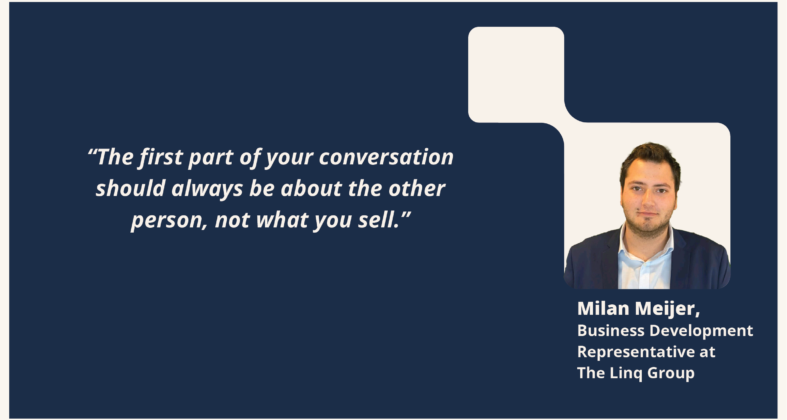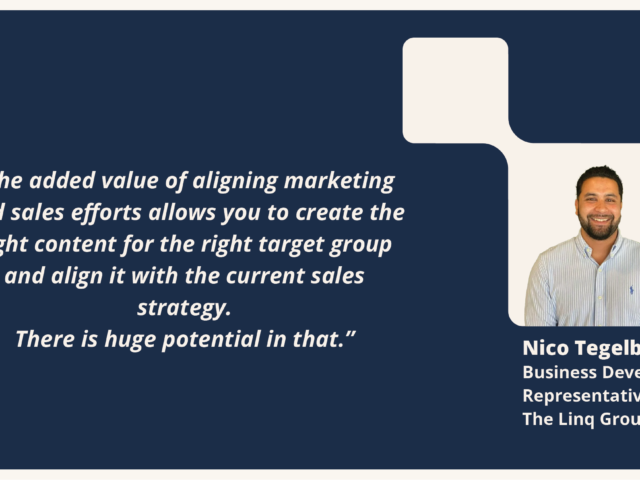How active listening will help you close more deals [+ how to use it in your sales strategy]

Let me introduce myself!
“Hi, my name is Milan! I am a Business Development Representative at The Linq Group, and together with my team, I am responsible for creating new collaborations with B2B companies. The main goal of a new collaboration is always to add value to the client’s sales process. In this post, I will give some insights into what I learned during my MANY sales conversations and how I use active listening to create more opportunities.” – Milan Meijer
Let’s dive in!
As a salesperson, listening is one of the most important tools you can use in your strategy. By actively listening, you can gain a better understanding of your prospects’ needs, pain points, goals, and objections. Apart from that, being present and showing genuine interest in your prospects and their challenges makes it much easier to build trust and credibility with them.
After all, there is something that is an inherent human need that, no matter how much the business landscape and our world changes, will stay the same – we want to be listened to and be understood. Because it makes our problems feel validated and meaningful.
Ultimately, a big part of your job as a sales professional is to solve your prospect’s problem through the solution you are selling.
So, in this post, I will dive into how active listening can improve your sales conversations and look at some practical tips and techniques to help you improve your active listening skills.
Table of contents:
- The power of active listening in B2B sales
- A framework for active listening in sales conversations
- Three pillars of successful active listening
- Overcoming active listening challenges
- Final thoughts: Let active listening drive your sales success
The power of active listening in B2B sales

“For the first 15 minutes, let your prospect talk. Listen carefully to what they are saying and understand where their pain points lie, what they need, and what their potential objections might be. This way, you will be able to tailor your pitch to their problem.”
A meaningful conversation happens when there’s a balance between speaking, listening, and validating. It’s this very balance that ensures both people feel valued and heard.
Even tough, as a sales professional, you want to focus on what you do best – selling – for your meetings to be effective, you have to lean more towards listening than speaking. Especially during the first part of the meeting.
Active listening helps establish a mutual understanding between you and the prospect. By the end of your conversation, both of you should agree on your prospect’s needs and the solution that can solve them. If this is not the case, they won’t move further in your sales process.
Also good to know: a Salesforce Research report found that 76% of customers expect sales reps to understand their needs and personalize their interactions. Active listening plays a crucial role in achieving this.
Passive listening, on the other hand, can negatively impact your success in meetings. Because if we feel like the other person is just waiting until you have finished your sentence so they can take over the conversation, your interaction will feel very disingenuous. In this case, you will likely have a difficult time trusting this person and won’t look forward to your next interaction.
A framework for active listening in sales conversations

“The first part of your conversation should always be about the other person, not what you sell.”
– Milan Meijer
When you interact with a prospect or a customer, it is important to stay in the moment. Tough conversations should be a two-way street in sales, especially at the outset; the scale should tip toward your prospect. This shift of attention ensures they feel valued and allows you to gather all the necessary information to help tailor your approach to their needs.
To navigate sales conversations more effectively, sales reps can follow a simple three-step framework:
- Acknowledge the challenges and needs of your prospect.
- Confirm your understanding of their needs, encouraging them to elaborate more on their problems.
- Clarify any ambiguities to build an understanding bond.
Three pillars of successful active listening

“One thing that is difficult for many salespeople, especially when you are very eager, is PATIENCE. But if you skip the listening part and jump right into pitching your solution, you may see some resistance from your prospect. But patiently listening and emphasizing with your clients can go a long way and also make future discussions about cross- and upselling more successful because you establish trust from the get-go.”
Active listening might come easier to some than to others, but either way, it is a skill that can be nurtured and perfected.
Here are the three main aspects to help you become a better active listener:
- Comprehension: Before any sales dialogue, arm yourself with knowledge. Understand your prospect’s industry, their position, and their challenges. But don’t rely on this information alone. True comprehension comes from immersing yourself in what is being said during your conversation. Ask yourself: What keeps them up at night? What is something that stresses them daily? And what does success look like to them?
- Retention: Let’s face it: there is only so much information that you can remember, especially after multiple sales calls and meetings. However, remembering (or forgetting) specific details can make or break a deal. Note-taking is your best friend in this case. Jot down key points, and ensure these notes are organized and accessible for future reference.
- Response: This is where the rubber meets the road. Responding effectively showcases your understanding and builds rapport. In non-visual communications, like phone calls, verbal acknowledgment is essential. Repeat the problems your prospect expresses to make sure you understand their needs correctly and to show them you are listening. Expressing genuine interest in the conversation and asking insightful questions will also help you establish trust.
Overcoming active listening challenges

Dealing with mental fatigue
Just as marathon runners hit a wall, sales reps can face mental fatigue, especially when selling over the phone. Focusing on someone else and being present and empathetic can be draining. And the best way to tackle this is by taking regular breaks. Grab your headphones and put on a meditation, go outside for a walk, have a coffee with a colleague, or find a quiet spot to just breathe. You can only be effective in your sales meetings if you can fully focus on your conversations.
Multitasking while you are on a call
Multitasking is something that we are probably all guilty of. While it might seem efficient to check your emails or look through LinkedIn while on a call, it significantly lowers your ability to truly engage with your prospect. In this case, you have to be strict with yourself. Whatever you are trying to do during your sales calls that is not relevant and valuable to the conversation, schedule time to do these things outside of your call. Put away distractions, close unnecessary tabs, and focus solely on the other person.
Jumping to conclusions and making assumptions
We have all been there. You are on a sales call, you have a conversation with your potential buyer, and their situation sounds very similar to calls you had before. In this case, it’s easy to jump to conclusions and assume you know what they need or what they will say next. However, each prospect is unique, and their needs may differ. To avoid making presumptions, adopt a mindset of genuine curiosity. Ask open-ended questions that encourage them to elaborate on their needs and challenges. By doing so, you will gain a more comprehensive understanding and also demonstrate your commitment to addressing their specific concerns.
Final thoughts: Let active listening drive your sales success
Active listening underlines the principle that selling isn’t just about pushing a product or service but about solving a problem and building relationships. As a B2B sales professional, nurturing this skill will not only set you apart but will also drive tangible results in your sales goals.
So, the next time you’re in a sales conversation, remember: Speak less, listen more, and let active listening be your guide to closing that deal.












